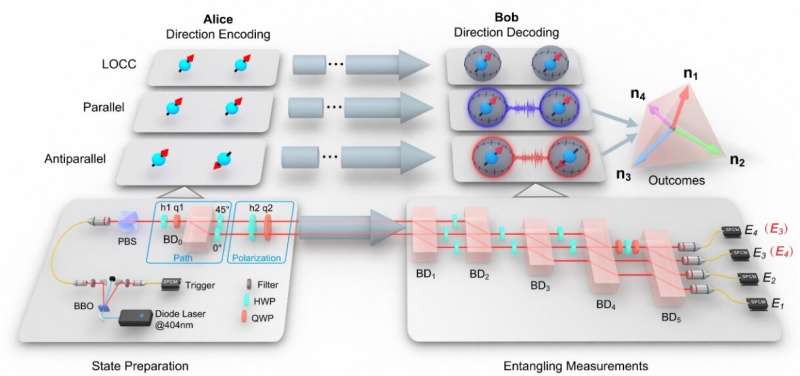The first quantum orienteering by quantum entangling measurements enhancement

The CAS key lab of quantum information, led by Prof. Guo Guangcan, Li Chuanfeng, Xiang Guoyong and collaborators, reports enhancing the performance of quantum orienteering with entangling measurements via photonic quantum walks. These results were published online by Physical Review Letters on February 13th.
Thanks to quantum entanglement, quantum information processing is much more efficient than its classical counterpart in such tasks as quantum computation, quantum communication and quantum metrology. Quantum entanglement can manifest itself in quantum states and quantum measurements. By contrast to the extensive research of entangling states, there are few experimental studies of entangling measurements because they are so difficult to realize.
In recent years, Prof. Guo-Yong Xiang et. al. developed a method of realizing quantum entangling measurements via photonic quantum walks, and their method not only has high fidelity but is also deterministic. They have used this technology to achieve unprecedented efficiency in quantum state tomography and to reduce the back action of quantum measurements in quantum thermodynamics. Recently, they used their technology to enhance quantum orienteering.
In quantum orienteering, Alice wants to use quantum resources to communicate a random space direction of military importance to Bob. One simple scheme is for Alice to polarize a spin along the direction and send it to Bob. As early as 1999, Nicolas Gisin from the University of Geneva found that the antiparallel spins were more efficient than parallel spins in quantum orienteering. That differs from the classical counterpart in which the efficiencies of the two direction encoding schemes are the same. There is no entanglement in quantum states on Alice's side, thus, it is the entanglement in quantum measurements on Bob's that boosts the efficiency.
As optimal entangling measurements on parallel and antiparallel spins are difficult to realize, there has been no convincing experimental implementation despite 20 years of research. Prof. Guo-Yong Xiang et. al. successfully realized such optimal entangling measurements via quantum walks. The experimental results clearly demonstrate that entangling measurements can extract more direction information than local measurements, and the fidelity of antiparallel spins is improved 3.9% over parallel spins in orienteering.
Their work demonstrated a truly nonclassical phenomenon derived from entanglement in quantum measurements instead of quantum states. This breakthrough offers an effective method to realizing entangling measurements in photonic systems. These results are of interest not only to foundational studies of quantum entanglement and quantum measurements, but also to many applications in quantum information processing.
More information: Jun-Feng Tang et al, Experimental Optimal Orienteering via Parallel and Antiparallel Spins, Physical Review Letters (2020). DOI: 10.1103/PhysRevLett.124.060502
Journal information: Physical Review Letters
Provided by University of Science and Technology of China





















